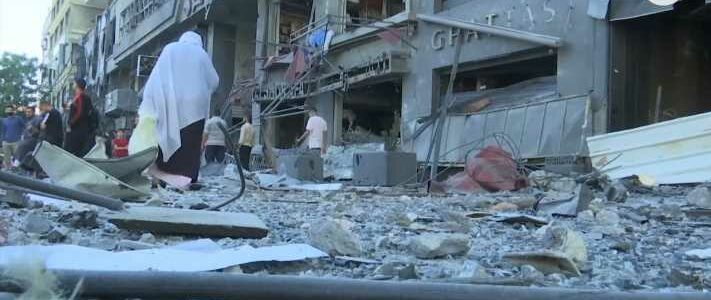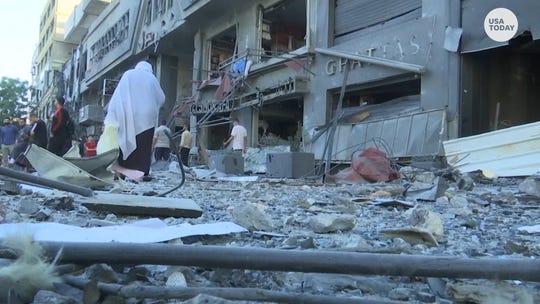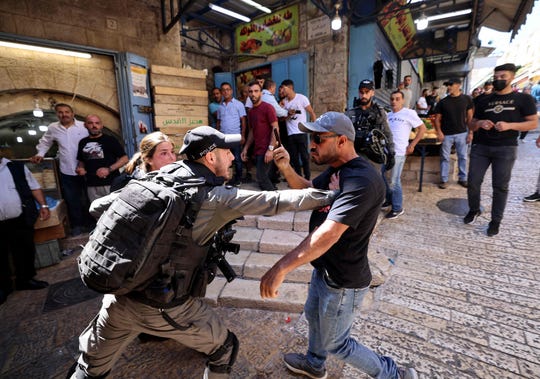
Cease-fire in Gaza: What we know about the Israel, Hamas agreement
WASHINGTON — Israel and Hamas halted an 11-day military conflict on Thursday night after both sides accepted a ceasefire brokered by Egypt.
The move followed growing pressure from President Joe Biden’s administration and others foreign leaders to de-escalate the conflict – which wrought far more devastation in Gaza than Israel and killed significantly more Palestinians. Hamas fired rockets indiscriminately into civilian areas in Israel while Israel pounded Gaza with airstrikes.
Israel described the agreement as “mutual and unconditional.” Biden hailed the truce and commended Netanyahu after the Israeli leader confirmed ithe cease-fire by phone Thursday evening.
Who has been killed in the Israeli-Palestinian conflict?
The latest Israeli-Palestinian conflict has been the worst outbreak of violence in the Mideast since 2014.
At least 230 Palestinians have been killed, including 64 children and 38 women, since the fighting began. Another 1,620 people have been wounded, according to the Gaza Health Ministry, which does not break the numbers down into fighters and civilians.
In Israel, 12 people, including a 5-year-old boy, a 16-year-old girl and a soldier, have been killed.
In addition, 58,000 Palestinians have been displaced from their homes during the conflict, while 18 hospital and clinics and a health facility were destroyed, according to the World Health Organization. The central COVID-19 testing lab in Gaza City was almost completely destroyed.
After 11 days of airstrikes targeting Hamas militants, Israeli Prime Minister Benjamin Netanyahu announced a case-fire Thursday brokered by Egypt, bringing an apparent end to its military operation in the Gaza Strip. (Photo: ASSOCIATED PRESS)
Biden sees ‘genuine opportunity’ for progress toward peace
In brief remarks Thursday, Biden said the deal opened an opportunity to seek a broader peace agreement amid the parties.
“I believe the Palestinians and Israelis equally deserve to live safely and securely and to enjoy equal measures of freedom, prosperity and democracy,” he said. “My administration will continue our quiet, relentless diplomacy toward that end. I believe we have a genuine opportunity to make progress and I’m committed to working for it.”
WASHINGTON, DC – MAY 20: U.S. President Joe Biden delivers remarks on the conflict in the Middle East from Cross- Hall of the White House on May 20, 2021 in Washington, DC. Israel and Hamas announced that they would agree to a cease-fire, which will take into effect on Friday, following days of fighting that claimed more than 200 lives. (Photo: Anna Moneymaker, Getty Images)
Biden extended his condolences to families of victims – Israelis and Palestinians. “These hostilities have resulted in the tragic deaths of so many civilians,” he said.
As the fighting escalated, Biden faced increasing pressure from Democrats to intervene more forcefully to stop Israel’s onslaught of airstrikes. On Wednesday, he called for a “significant de-escalation” from Netanyahu, but Israel continued its operation.
Recounting his Thursday phone call with Netanyahu – his sixth in recent days – Biden said he reiterated the U.S.’s “full support” of Israel to defend itself against Hamas. He also vowed the U.S. will help replenish Israel’s sophisticated Iron Dome missile defense system, which limited casualties in Israel.
Biden said the U.S. took part in “intensive high-level discussions, hour-by-hour, literally” with Egypt and other intermediaries to avoid a prolonged conflict. He credited Egyptian President Abdel Fattah Al-Sisi for his role in brokering the deal.
How the conflict started
The fighting began when Hamas militant groups fired rockets toward Jerusalem following days of clashes between Palestinian protesters and Israeli police in Jerusalem near the Al-Aqsa Mosque compound, a site sacred to Jews and Muslims.
Palestinians were protesting an effort by Jewish settlers to evict Palestinian families from their homes in East Jerusalem.
An Israeli border police officer confronts a Palestinian man during protests in east Jerusalem on May 18, 2021. (Photo: Emmanuel Dunand/AFP via Getty Images)
Hamas, which controls Gaza, fired thousands of rockets at civilian targets in Israel, sending Israelis scrambling to bomb shelters. The vast majority Hamas’ rockets were intercepted by the Dome missile defense system.
Israel responded with its own fusillade of missiles aimed at degrading Hamas’ military capability and killing its leaders. Gaza is home to approximately two million Palestinians.
What’s next?
Hostilities between Israel and Palestine remain high and go back decades.
Even as a cease-fire was reached, Israel’s Defense Forces said sirens alerting Israeli residents of Hamas rocket fire were sounding in the south of the country.
Taher Nounou, a Hamas official, confirmed the deal: “The Palestinian resistance will commit itself to this deal as long as the occupation is committed,” he said.
Biden vowed “rapid humanitarian assistance” through the United Nations to the people of Gaza, making it clear it would be made through partnership with Palestinian authorities, not Hamas.
Both sides will be on edge as the truce goes into effect, and with tensions still high, some worry it may not hold. Meanwhile, the United Nations and other relief organizations will launch a massive relief and reconstruction effort in Gaza, which bore the brunt of the casualties and infrastructural damage.
Contributing: Kim Hjelmgaard, Maureen Groppe and Associated Press. Reach Joey Garrison on Twitter @joeygarrison.
Source: Read Full Article


